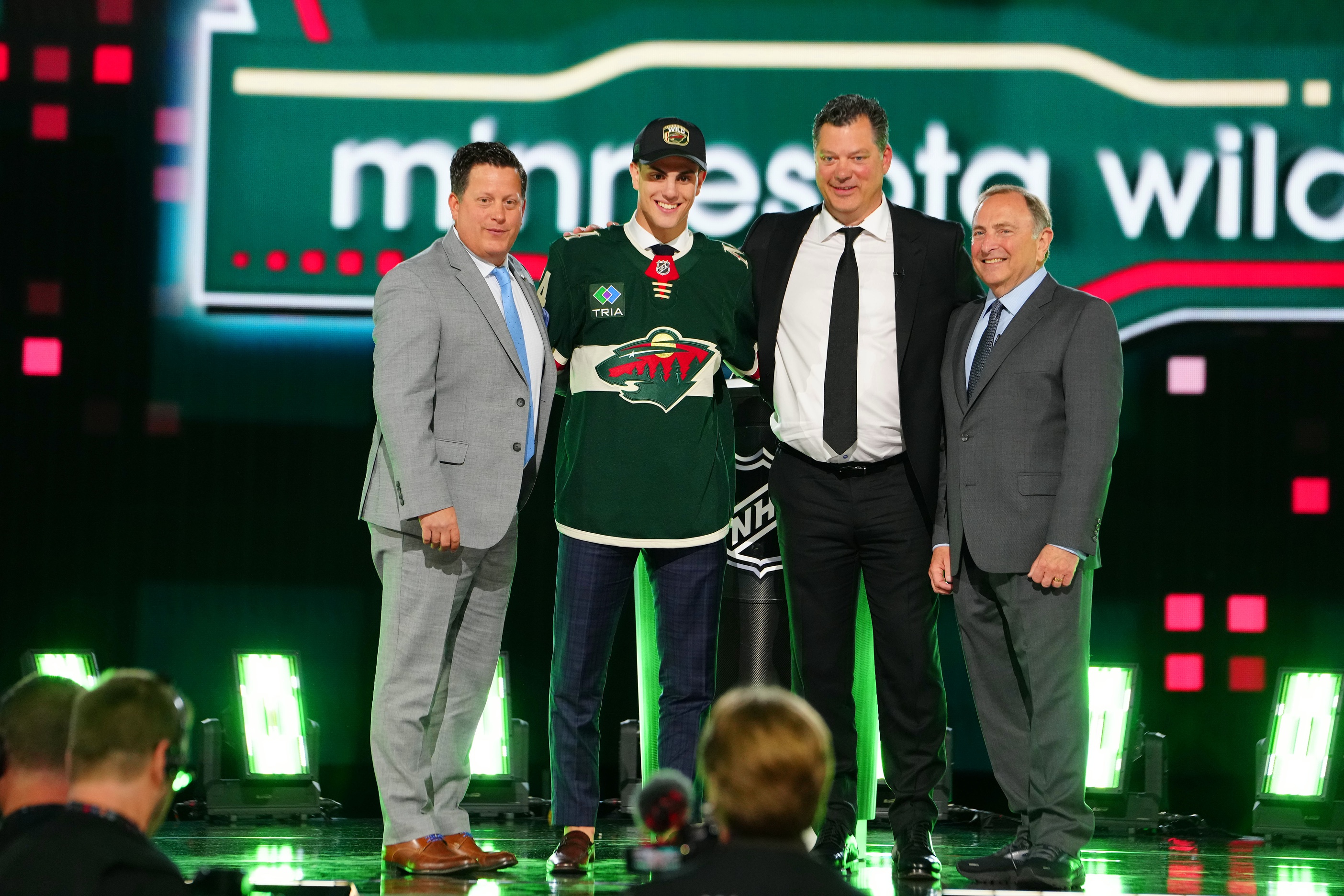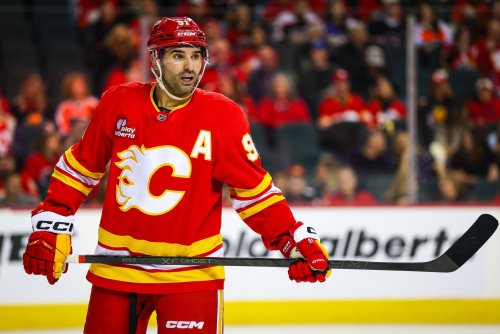
By far, the most popular person at the Draft is "Best Player Available." Ask a group of fans who their team should take, and it won't be long before ol' BPA's name starts coming up. And honestly, why shouldn't a fan not want their team to take Best Player Available? It's not like they're not going to find someone else that's better.
Last year, the Minnesota Wild were roundly criticized for picking Charlie Stramel over Gabriel Perreault. Minnesota was trying to address an organizational need, prioritizing a big center over a smaller, slower winger. Still, the criticism only intensified after Perreault dominated at Boston College and Stramel struggled for minutes at Wisconsin. It led fans to beg this year for Minnesota to simply take "Best Player Available" in 2024.
The Wild entered the 2024 NHL Draft needing a premier defenseman in their pipeline. They graduated Calder Trophy runner-up Brock Faber last year, but in the system, blueliners like Carson Lambos (Round 1, 2021), Ryan O'Rourke (Round 2, 2020), and Daemon Hunt (Round 3, 2020) have failed to launch. Luckily for Minnesota, the Wild were able to fill their biggest need and take the clear-cut Best Player Available in Zeev Buium.
It's a pretty rare pairing to get outside of the top, top picks of the Draft, as there is rarely a bona-fide, slam-dunk Best Player Available outside of the very top of the draft. For example, on his 2024 Draft Board, Corey Pronman groups his prospects into tiers. Here's how many players there are per tier:
Tier 1 (Elite NHL Player): 1
Tier 2 (Elite/NHL All-Star Bubble): 1
Tier 3 (NHL All-Star): 3
Tier 4 (All-Star/Top-of-the-Lineup Bubble): 3
Tier 5 (Top-of-the-Lineup Player): 3
Tier 6 (Top/Middle-of-the-Lineup Bubble: 7
Tier 7 (Middle-of-the-Lineup Player): 21
Tier 8 (Projected NHLers): 34
Tier 9 (Has a Chance): 56
It thins out fast, and there's often little distinction between the player that's considered BPA, and the next guy. Sure, scouts number their lists, because when push comes to shove, you've got to take someone. But the guys who are obviously head-and-shoulders over the next player are gone early, because well... they're obviously better.
For example, Buium (ranked No. 5 overall by Pronman, Tier 3), wasn't going to be available at pick No. 13 for the Wild. Had the Philadelphia Flyers "Stick and Pick"ed at 12th overall, or another team out-bid Minnesota's offer of a third-rounder to move up one spot, Buium would surely have been gone. At that point, the Wild would have (likely) decided to draft the BPA or do a slight reach for the next-best defenseman. Their trade ensured that didn't have to happen. Judd Brackett got His Guy.
Pronman putting Buium No. 5 in the draft class was far from an outlier. Scott Wheeler at The Athletic ranked Buium No. 4. TSN's Bob McKenzie, who compiles NHL scouts' opinions to create his rankings every year, had Buium at No. 7 on his final draft list. McKenzie's colleague Craig Button had him fourth. Elite Prospects had him seventh. There were some outlets, such as Elite Prospects, that had Konsta Helenius (No. 14 overall, Buffalo Sabres) ranked above Buium, but in most people's opinions, Buium was the slam-dunk Best Player Available.
And again, this Top-4-to-7 player in the draft not only fell to the Wild's range, but perfectly fits their needs. It goes beyond the fact that the Wild needed a defenseman, or a bona fide, top-pairing-caliber left-shot defenseman as a counterpart to the right-shot Faber. For all the talk about the Wild needing to add size to their blueline, the organization was completely devoid of the sheer levels of offensive upside Buium brings to the table.
If the likes of Lambos, Hunt, O'Rourke, Jack Peart (Round 2, 2021), or David Spacek (Round 5, 2022) pan out, they'll be largely in the same mold. They can skate, they can defend, they can play two-way hockey, but they aren't flashy. Even Faber, who surprised the NHL by being strong on the power play as a rookie, doesn't have that elite level of skill and creativity.
You're going to hear a lot about Buium's hockey sense and offensive awareness, but that doesn't mean we should overlook his raw skill level. He can weave pucks through or around defenders with crazy moves, while showing enough puck control to place them right on his teammates' sticks. McKeen's Hockey rated him as the No. 4 Playmaker in the Draft and the No. 7 Best Puckhandler. Both of these lists include forwards, with him being behind only Macklin Celebrini (No. 1 overall), defenseman Zayne Parekh (No. 9), and Berkly Catton (No.8) on both lists.
But then, dear readers, there is the hockey sense. Buium works the ice like a board game, concealing his intentions from his adversaries like he's playing Risk, building roads for the puck like he's playing Catan, and making his opponents pay like he's playing Monopoly. "His [skating] and deception have gone from a strength to a game-breaking (or darn near) quality," says Wheeler in his rankings. "His head is always on a swivel."
As great as Buium is in the offensive zone, his puck-moving ability is perhaps every bit as rare and critical in the Wild system. While Jared Spurgeon, Jonas Brodin, and Faber have puck-moving chops, they don't get the sheer amount of clear, easy breakouts that Buium did at Denver last season. Exiting their own zone and entering the offensive zone tends to be a shortcoming for Minnesota, and Buium can fit nicely as the Wild's top puck-carrier in short order.
Elite Prospects, who ranked Buium as the best transition defenseman in the draft (as well as the No. 4 offensive defenseman), goes into detail about his breakout game in their Draft Guide. "Buium scans ahead of each retrieval, plans his escape route in advance of collecting the puck, makes sure to draw in at least one forechecker, and then beats them with near-comical ease." His brain, feet, and hands work in concert to deliver something even better than the sum of their impressive parts.
All of that is great, these are the kinds of skills Minnesota doesn't get picking in the mid-teens to late-20s in most drafts. On top of all of these great things, though, we have his production, which could not have been better for the freshman. Buium finished second on his team with 50 points (Florida Panthers forward prospect Jack Devine was first with 56), and 10th overall in NCAA scoring.
He was not just the top-scoring defenseman in the country this year (as a freshman!!!), but he also has the record for the most points of any draft-eligible defenseman, ever. Since 1977-78, that record was held by the University of Minnesota-Duluth's Curt Giles (49 points), who went on to have a long career with the Minnesota North Stars. In comes Buium, and a nearly 50-year-old record falls.
So if he stacks up well against college defensemen from the high-flying, stand-up goalie 70s, how much farther ahead is he in front of recent draft-eligible NCAA defensemen? Let's take a look at the top players since 2000:
1. ZEEV BUIUM, 2023-24: 11 goals, 50 points (42 GP)
2. Artyom Levshunov, 2023-24: 9 goals, 35 points (38 GP)
T-3. Quinn Hughes, 2017-18: 5 goals, 29 points (37 GP)
T-3. A.J. Thelen, 2003-04: 11 goals, 29 points (41 GP)
5. Adam Clendining, 2010-11: 5 goals, 26 points (39 GP)
T-6. Zach Werenski, 2014-15: 9 goals, 25 points (35 GP)
T-6. Charlie MacAvoy, 2015-16: 3 goals, 25 points (37 GP)
8. Noah Hanifin, 2014-15: 5 goals, 23 points (37 GP)
T-9. Owen Power, 2020-21: 3 goals, 16 points (26 GP)
T-9. Cullen Eddy, 2006-07: 5 goals, 16 points (35 GP)
The top of this list is chock-full of extremely impressive names. Even Thelen, who went on to be a bust for Minnesota, at least has a claim to being the most impressive bust in Wild history. But in all seriousness, topping 2024 No. 2 overall pick (and new Chicago Blackhawk) Levshunov, 2023-24 Norris Trophy winner Hughes, 2021 No. 1 overall pick Power, and high-end defensemen like Werenski, MacAvoy, and Hanifin, is attention-grabbing.
So is being the most important player on a championship team as a freshman. According to Elite Prospects, Buium played the most all-situation minutes in the NCAA last year (coming out to 25 minutes and 50 seconds per game). He wasn't a power-play specialist, Denver threw him over the boards as much as he could handle, and it still wasn't too much.
This includes 29:29 of ice time in the Frozen Four Final, where he held a Boston College lineup including first-round picks in Perreault, Will Smith, Cutter Gauthier, and Ryan Leonard to zero points. He also got the assist on Wild prospect Rieger Lorenz' 2-0 goal in the second period, which would stand as the final score. This play was featured in a highlight reel above, but let's watch the biggest point of Buium's life again.
Yes, 12 teams passed on him (counting the Flyers, who made the trade with Minnesota), but they did so at their own risk. Buium's talents weren't unknown to the rest of the NHL, as evidenced by the scramble to the Philadelphia phone lines when Buium was for the taking at 12th overall.
"He seems so safe. I think he has some Adam Fox to him. Talk about elite brain power, vision, deception," says an NHL scout before issuing a warning to the Blackhawks and 10 other teams. "Levshunov is going to go higher because of his size and strength. I get that. But it's hard to pass on Buium. I'd be losing sleep with that."
Brackett didn't pass on Buium, and he had absolutely zero reason to. He got the guy everyone wants: Best Player Available. And as luck would have it, our friend BPA slots in exactly in that prototypical, power-play quarterbacking No. 1 defenseman mold that his organization was missing. It's very rare for a team starting with the No. 13 pick to have the draft break their way quite as well as it did for the Wild.
Think you could write a story like this? Hockey Wilderness wants you to develop your voice, find an audience, and we'll pay you to do it. Just fill out this form.
-
 4
4






Recommended Comments
Join the conversation
You can post now and register later. If you have an account, sign in now to post with your account.
Note: Your post will require moderator approval before it will be visible.